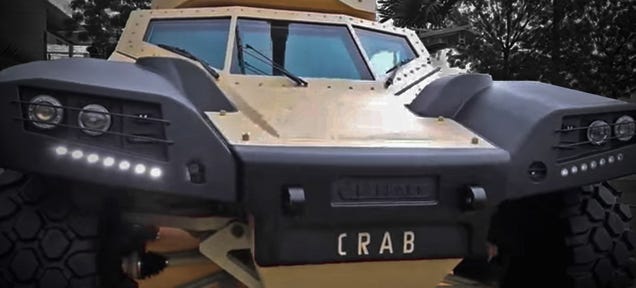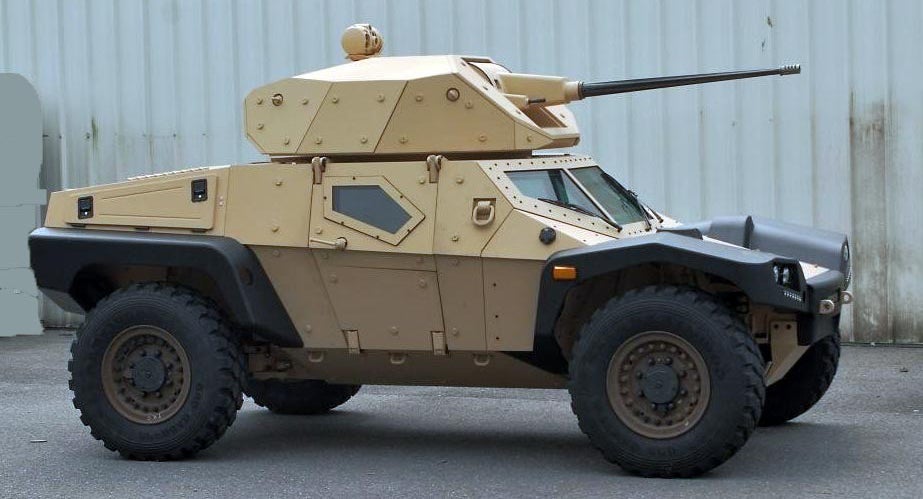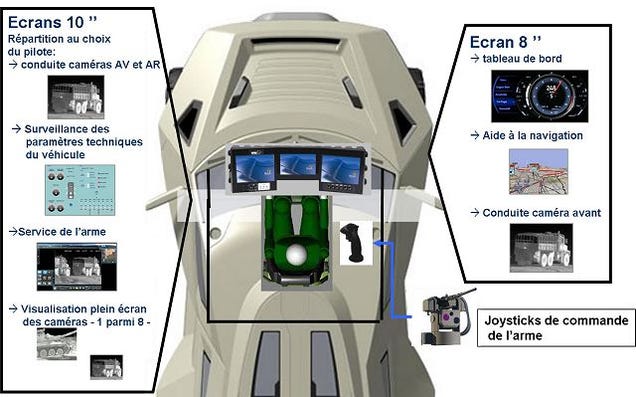
France's military vehicle (and once upon a time carmaker) Panhard has set out to change the way the weapons industry looks at a scout vehicles with their new three person armored buggy that can pack one hell of a punch. They call it the Crab, and like its namesake it can even move sideways.

Does the Crab, which stands for "Combat Recce Armored Buggy," look like an almost perfect hybrid of Halo's Warthog and Batman's Tumbler? Yes. Could it revolutionize the way scout vehicles are procured and employed on the battlefield? Possibly. The Crab is more than the sum of its parts, of which many are innovative but not necessarily ground-breaking.
The concept aims at creating a vehicle that is affordable and able to partake in every stage of a military operation including commitment, engagement, stabilization and normalization, and can operate in an offensive, defensive or a security manner. In other words, a customer can get their money's worth out of this little war wagon throughout an entire conflict's cycle. Still, the Crab is a scout vehicle at heart, built for lightning quick raids and sparring with the enemy, stealthily reconnoitering the battlefield for heavier forces and calling in heavy firepower from the rear.
There are a couple potential poweplants being looked at for the Crab, which all are mounted in the rear of the vehicle and come in at between 300hp to 400hp. One configuration includes a 400amp starter/alternator and a pair of large battery packs which would give the Crab an extra punch in performance when needed and could also allow it to crawl along silently in high-threat environments.
Additionally, a pair of advanced solar panels on its rear deck help in the charging of these batteries during daylight hours and they would also allow it to sit electronically powered up for long periods of time. The Crab's low slung design, while still offering substantial ground clearance, and its faceted structure will also help lower the vehicle's radar signature, a trait that is becoming quite important on the modern battlefield.
The Crab has an all-time four wheel drive system and both axles are independently steerable which gives the Crab incredible maneuverability and a turning ability inside of a 30 foot diameter Seeing as the Crab has all wheel steering, it can also drift from side to side, like a crab, with minimal forward movement, which is sort of an action star's dream for a strafing scene in a summer blockbuster is it not? Even in reverse, the lightly armored Crab is incredibly nimble via a high-speed reverse gear and a 360 degree camera system that is repeated on the driver's wrap-around display console.
The suspension on the Crab is inspired by desert racing vehicles and features a hydro-pneumatic suspension with adjustable ground clearance (up to 450mm) and is built for relative comfort and stability even at high-speed over rough terrain.

European military electronics masters Thales is working with Panhard on outfitting the Crab with a state of the art electronic combat system. The interior of the Crab seats three crew members in racing-like seats arranged in a "V" seating configuration. The driver sits in the center of the vehicle upfront and has access to a modern re-programmable sports car like LCD instrument cluster and large flat-panel multi-function displays on each side which together can repeat imagery repeated from the Crab's 360' persistent camera system. Its armored windshield, which is made form the clearest blast proof/ballistic glass available, is optimized for forward and upward visibility which is a huge plus in urban combat situations.

Behind the driver sits two crew which can control sensors, radios and whatever type of weaponry the Crab is carrying. Each crew member has a large multi-function display and control stick with multi-function buttons. By utilizing an "open architecture" concept which Thales calls the "Scorpion Human Machine Interface" (HMI) each station can do the other's job, aside from driving, so technically the driver could work the gun turret or monitor data-linked information without changing seats, while the other crew members performs other tasks, stands watch, or rests. This same concept, along with plenty of interior space, allows for the Crab to have new modular sub-systems added to it with ease in a true "plug and play" nature. This upgradability will save big bucks throughout the vehicles life-cycle. Additionally, an on-board wireless intercom system allows the Crab's crew to talk easily among themselves even when they are dismounted from the vehicle, up to about 750 feet away from the vehicle.

The Crab's outer "shell" is armored to level two STANAG protection, but it can be upgraded to level four if the mission dictates, and slat armor can be added to help protect against rocket propelled grenades (RPGs) albeit with some added weight and cost.
Panhard's engineers came up with an interesting solution for protecting the Crab against mines and buried improvised explosive devices (IEDs), a tactic that has been all to familiar over the last decade of fighting insurgencies in Iraq and Afghanistan. Instead of a cumbersome "V" shaped hull, that deflects the force of a ventral blast outward and upward but results in vehicles with greatly reduced ground clearance or obscene ride height (see the various MRAPs for example), the Crab has a series of "false floors" that work as a shock absorber by crumpling during a blast. The outer hull of the crab is angled to help direct the remaining blast force out and away from the vehicle and the Crab's fenders are lightweight and ventilated which will help alleviate the lifting "heave" and resulting crash of blast. Finally, the racing-like seats installed in the Crab's cabin will have advanced shock absorbing properties similar to a helicopter's crash seat, which will greatly reduce trauma to its occupants in such an attack as well as making the Crab much more comfortable to ride in while cruising off-road at high speeds for prolonged periods of time.
When it comes to firepower the Crab is not just a scout vehicle, it is a transformer. This buggy-like combat vehicle can be configured with different weaponry and sensors for different missions, from a remote controlled 7.62mm or 50 calibur machine gun up to a 30mm cannon or a 40mm grenade launcher, all housed inside of a fully articulating turret. The pictures seen here show the Crab equipped with the proven M242 25mm Bushmaster cannon. Depending on the ammo used, the M242 can knock out main battle tanks at relevant ranges (Bradley Fighting Vehicles equipped with same cannon were known to knock out T-72s during operations in Iraq). In this configuration the Crab could hold a total of 150 rounds of two types of ammo, which are usually armor piercing and high-explosive.
Along with the 25mm Bushmaster a coaxial 7.62mm machine gun can also be mounted inside the same turret, which offers a wide variety of weapons effects for such a small vehicle. Regardless of what is mounted in the weapons turret, it can be accessed via the Crab's cabin for maintenance and reloading.
Other configurations have the Crab outfitted with large high-power observation sensors, point defense surface to air missiles and anti-tank guided missiles. A command and control outfit is also in the works apparently.
For targeting, the Crab can pack a myriad of sensors, including infrared, electro-optical, and even a mast mounted radar similar to what is currently deployed on the AH-64D/E Apache attack helicopters. Such a system can be quickly raised to rapidly build a "picture" of the area around the vehicle, including classifying ground targets and providing engagement quality targeting for its own or other weapons platforms' to utilize.
As scout vehicle, the Crab could use its radar system to call in artillery or guided rocket strikes from dozens of miles away without ever even being seen. Additionally, such a modular milimetric wave radar system could also provide detection and cuing for surface to air missile systems against low flying aircraft and helicopters. Such a capability would give a crab outfitted with point defense surface-to-air missiles a potent "all in one" high-mobility air defense capability, which would not have to rely on external radar sources for situational awareness and initial targeting.

The whole concept of Panhard's Combat Recce Armored Buggy was to build a vehicle that is truly a scout-reconnaissance vehicle at heart, not an all too common over-grown caricature of one. Its designers, along with the French military, want something extremely mobile, reliable, highly adaptable and purpose built for scouting duties yet capable of many more missions by default, and the Crab concept, if executed properly in a production form, should deliver this. Furthermore, the Crab is highly deployable without being dismantled first. A single C-130J Super-Hercules can hold two Crabs and an A400M can hold three of these vehicles. Both these aircraft can land at forward operating locations with minimal support infrastructure and rough landing surfaces. This means the Crab can be flown directly into the area of operations and can roll off their transports ready to go to work.
In many ways the Crab is the F-16A of yesterday, it can do a lot of different missions, has fantastic crew interface, is extremely nimble and fast and can still pack a powerful punch when asked to. And it aims to do this without introducing such radically new technology that the unit cost will begin balloon or its reliability rate will be questionable from the get-go.
Additionally, the Crab is just Panhard's next evolution of their successful (almost 2500 built) and highly adaptable VBL lightly armored vehicle that it aims to replace. So a pedigree of cost effectiveness and reliability exists for the Crab with its direct lineage to the VBL and many more decades full of other successful light armored vehicles built by Panhard.

Finally, the whole Crab concept is supposed to come in at an attractive price. Panhard is fully aware of shrinking defense budgets both at home and abroad, and Armée de Terre is not the only customer they are after.
Outside of Europe, South America and even Pacific nations are being eyed as possible customers for the Crab, although the Middle East is possibly the largest potential foreign market. Countries like the United Arab Emirates, Qatar, Kuwait and even Saudi Arabia could use the Crab as a desert border patrol asset during times of peace and a penetrating scout vehicle during times of war. Traditionally, Arab countries love their light attack and scouting vehicles, especially their helicopters, as they are affordable, nimble and deadly machines that really have made sense in past conflicts on the Arabian Peninsula. Also, the arms market is extremely strong in that part of the world and buyers seem to be more than willing to invest into new concepts and technologies.

The US Army and even the USMC may also be wise to drop their heavy-weight armor obsession and take a good look at this low-slung armored chariot. The Crab could fill the gap between the aging missionized Humvees and the upcoming Joint Light Tactical Vehicles and their heavier Bradley Fighting Vehicle and Stryker Armored Fighting Vehicle cousins currently being used for scouting, reconnaissance and raiding. Additionally, such a system would be a very useful upgrade to replace or augment the special forces communities' unarmored dune-buggy likeDesert Patrol/light Strike Vehicles.
Hopefully the Crab will pan out for Panhard and we will see the high-performance armored raider in service by around 2018, which may be good market timing incidentally, and maybe, just maybe, we will be lucky enough to see some with US Cavalry markings on their hoods and doors and possibly a few painted flat black and heavily armed for special forces operators to take full advantage of. If Panhard lives up to its promises, the Crab may just end up being the hard shelled, ultra-agile scout vehicle of the future that is also aptly equipped with very sharp claws...
Panhard's Crab May Just Be The Future Of Armored Scout Vehicles







